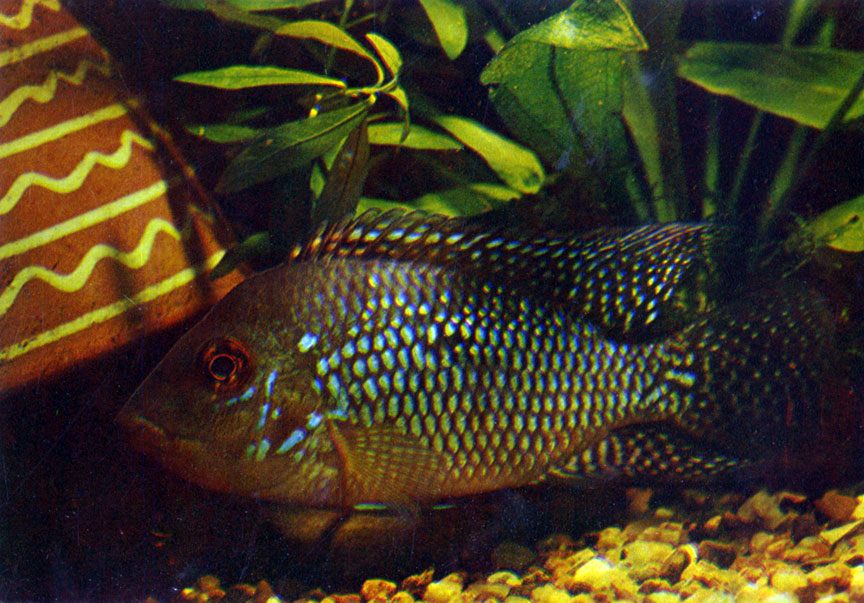
4. Бразильский геофагус Geophagus brasiliensis (Quoy et Gaimard, 1824)
Населяет водоемы Восточной Бразилии. В СССР аквариумисты содержат с 1976 года. Изумрудно-бирюзовое тело и плавники рыб усеяны жемчужными точками. Самцы ярче и крупнее самок. Размер до 30 см (обычно 10 - 15 см). Животноядный вид. Созревают за 8 - 10 месяцев. Нерест парный. Продуктивность до 1000 икринок. Икру откладывают на камень и т. п. Молодь начинает самостоятельно питаться через десять дней при Т 26°С. Корм - мелкий планктон (коловратка, науплии циклопа и т п.). Малек серо-зеленый. Условия содержания: dGH до 20° рН 6.5 - 7,8. Т 20 - 25°С.

Бразильский геофагус Geophagus brasiliensis (Quoy et Gaimard, 1824)
Geophagus brasiliensis (Brazilian Earth-eater) inhabits waters of Eastern Brazil. In the USSR the hobbyists have been keeping this species since 1976. Emerald-turquoise body and fins are covered with pearly blotches. Male brighter and larger than female. Grows up to 30 cm (usually 10 to 15 cm) in captivity. Live food of all kinds. Sexually mature at 8 to 10 months. Spawning in pairs. Fecundity up to 1,000 eggs. They lay the eggs on a stone. The young begin to feed in 10 days at 26°C. Feeding commences with small zooplankton (rotifers, Cyclops nauplii, etc.). Juveniles are greyish-green. Water conditions: dGH to 20°; pH 6.5 - 7.8: temperatures 20 to 25° C.
Geophagus brasiliensis puebla las agues dulces del Brasil oriental. Es cultivada en la URSS desde 1976. El cuerpo de color entre esmeralda у turquesa у las aletas de estos peces son salpicados de manchitas perladas. Lot machos aventajan a las hembras en cuanto al tamano у vivacidad de colores. Los peces pueden alcanzar unos 30 cm, no pasando, ordinariamente, de 10 - 15 cm. Son carnivores. Pubescen a los 8 a 10 meses. El desove lo realizan en parejas, poniendo las hembras hasta mil huevas en algun substrate solido como, por ejemplo, fondo pedregoso, etc. Con la temperatura de 26° C, los alevines empiezan a buscar alimento al decimo dia de su vida. Les sirve de pasto el plancton menudo (rotiferos, larvas de ciclopes, etc.). Las crfas son de color verde grisiceo. Condiciones de cultivation: dGH no mas de 20°; pH 6,5 - 7.8; Т de 20 a 25° C.
|
ПОИСК:
|
© Злыгостев Алексей Сергеевич, 2001-2019
При использовании материалов сайта активная ссылка обязательна:
http://aquariumlib.ru/ 'Библиотека по аквариумистике'
При использовании материалов сайта активная ссылка обязательна:
http://aquariumlib.ru/ 'Библиотека по аквариумистике'